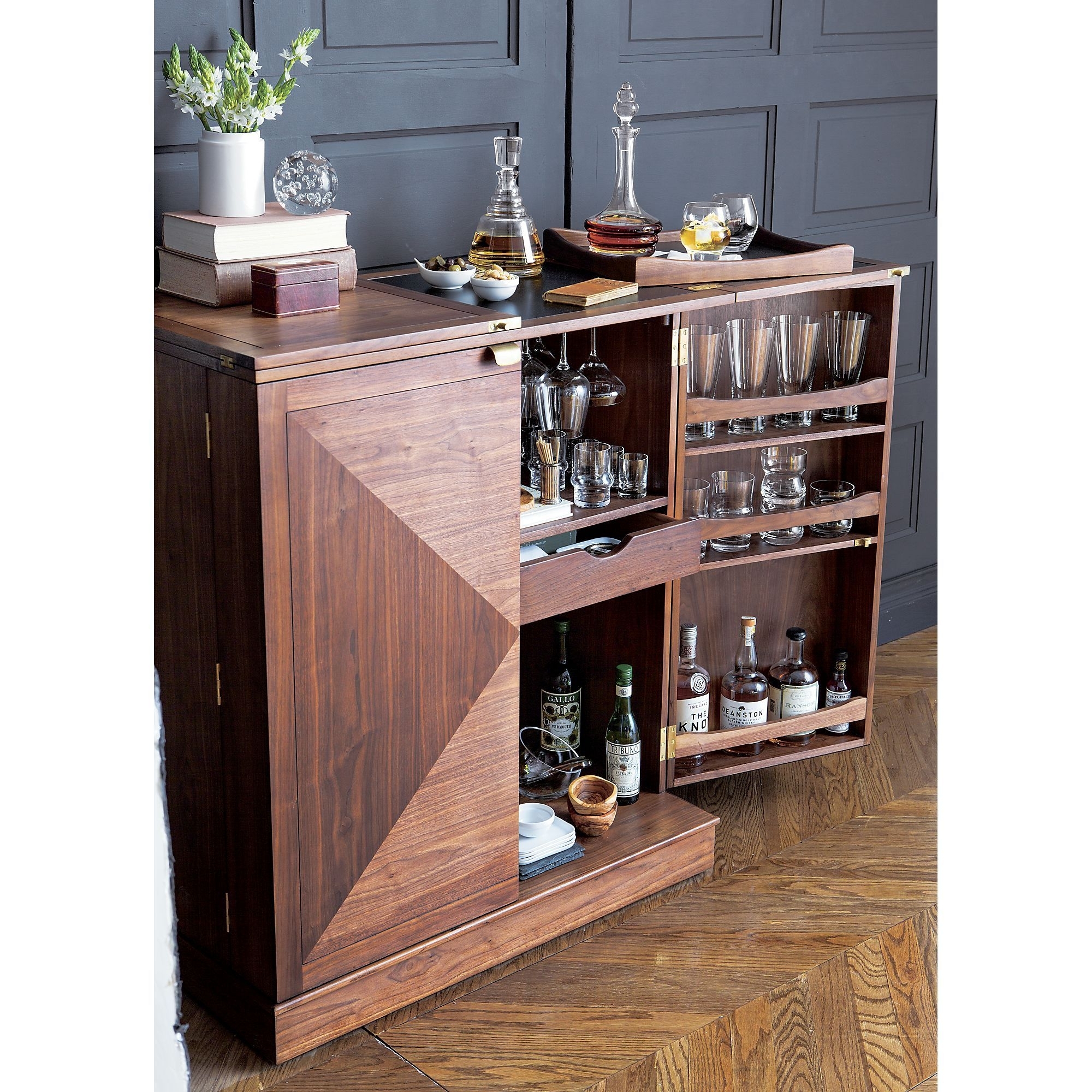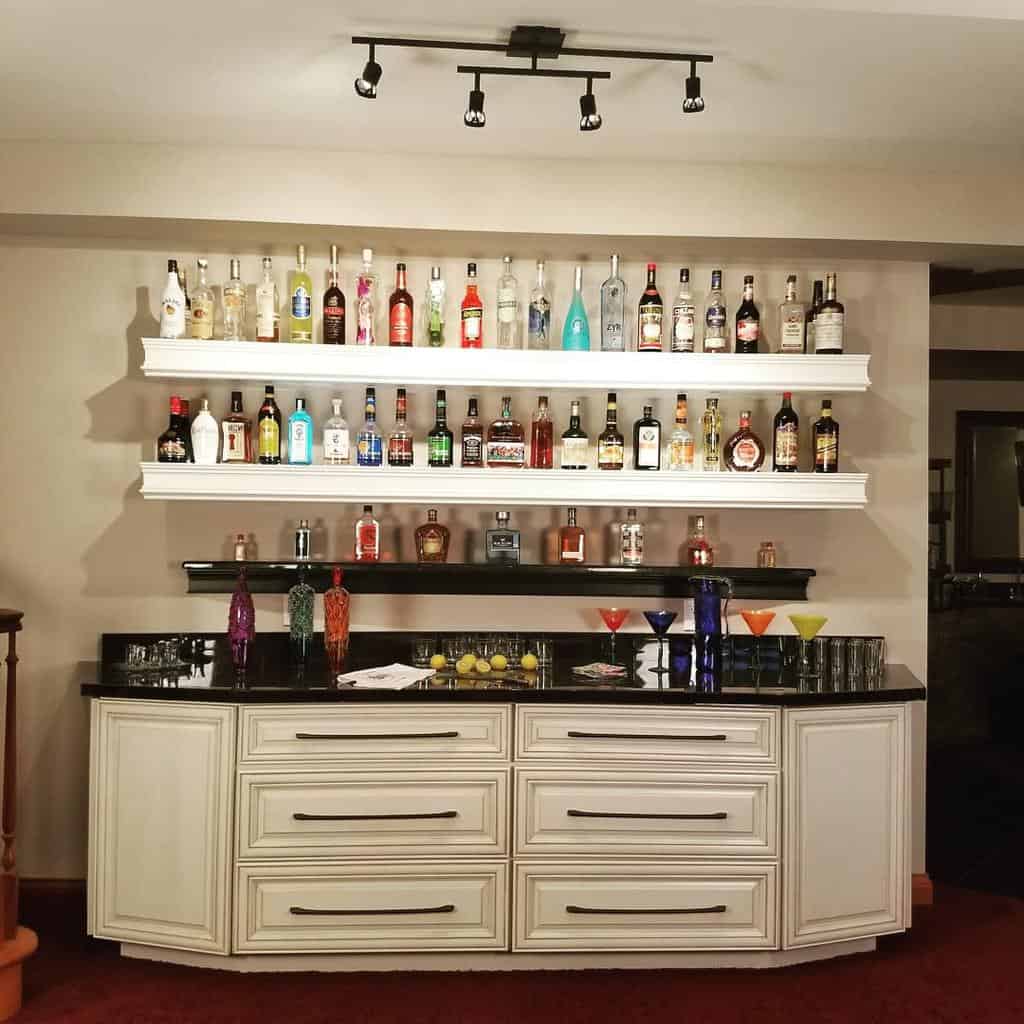Planning Your DIY Small Liquor Cabinet

Building a small liquor cabinet can be a rewarding project that adds a touch of elegance and functionality to your home. A well-designed cabinet not only provides storage for your spirits but also becomes a stylish focal point in your space.
Determining the Ideal Size and Dimensions
The ideal size and dimensions for your small liquor cabinet will depend on your available space and the amount of liquor you plan to store. Consider the following factors:
- Available Space: Measure the area where you intend to place the cabinet. Allow enough room for opening doors and accessing the contents.
- Storage Needs: Determine the number of bottles you need to store and the types of glassware you want to accommodate. This will help you decide on the number of shelves and compartments.
- Height and Depth: A small liquor cabinet can be anywhere from 30 to 40 inches tall and 18 to 24 inches deep. This range provides sufficient storage while maintaining a compact footprint.
- Width: The width of the cabinet will depend on the space you have available. A cabinet that is 12 to 18 inches wide can accommodate a decent collection of bottles.
Essential Tools and Materials
You will need a few essential tools and materials to build your small liquor cabinet:
- Power Tools: A circular saw, jigsaw, drill, and sander will be helpful for cutting, drilling, and finishing the wood.
- Hand Tools: A measuring tape, level, pencil, hammer, and screwdriver are essential for accurate measurements and assembly.
- Wood: Choose a sturdy wood like plywood, MDF, or hardwood for the cabinet structure. Consider using a water-resistant material for the shelves.
- Hardware: This includes hinges, door handles, drawer slides, and shelf supports. Select hardware that complements the style of your cabinet.
- Finish: Choose a stain, paint, or sealant to protect the wood and enhance the appearance of your cabinet.
Designing a Layout Plan
Before you start building, create a detailed layout plan for your small liquor cabinet. This will help you visualize the final design and ensure that all components fit together properly.
- Shelves: Plan the number and spacing of shelves to accommodate your bottle collection. Consider adding adjustable shelves for flexibility.
- Compartments: Create compartments for storing glassware, bar tools, or other accessories. A pull-out drawer can be useful for storing smaller items.
- Storage Options: Think about adding a wine rack, bottle holder, or a built-in ice bucket to enhance the functionality of your cabinet.
- Doors: Decide on the type of doors you want to use. Consider single doors, double doors, or sliding doors, depending on the size and design of your cabinet.
Choosing the Right Wood or Materials
The choice of wood or materials will depend on your budget, desired aesthetic, and the level of durability you need.
- Plywood: A cost-effective option that is strong and stable. It is available in various thicknesses and finishes.
- MDF: Medium-density fiberboard is a smooth and consistent material that is easy to work with. It is often used for cabinet doors and panels.
- Hardwood: Oak, cherry, maple, and walnut are popular choices for building high-quality cabinets. Hardwood provides a natural beauty and durability.
- Reclaimed Wood: Using reclaimed wood adds character and sustainability to your project. It is often available in unique textures and colors.
Cabinet Door Styles and Hardware
The style of your cabinet doors and the hardware you choose will significantly impact the overall look of your liquor cabinet.
- Door Styles: Popular choices include shaker doors, raised panel doors, and flush doors. Each style has a distinct appearance and can complement different design aesthetics.
- Hardware: Cabinet hardware includes hinges, door pulls, and knobs. Choose hardware that matches the style of your cabinet and adds a finishing touch.
Building Your DIY Small Liquor Cabinet

Now that you have a clear vision for your liquor cabinet, it’s time to bring it to life. This section will guide you through the construction process, step by step.
Assembling the Cabinet Frame
Building the frame is the foundation of your liquor cabinet. You’ll need to cut and join the pieces of wood that will form the sides, top, and bottom of your cabinet. Here’s how:
- Cut the Wood: Using a saw, cut your wood to the desired dimensions. Ensure all cuts are accurate and precise for a sturdy frame.
- Join the Pieces: Use wood glue and screws to join the sides, top, and bottom of your cabinet. Apply glue evenly and clamp the pieces together until the glue dries.
- Reinforce the Corners: For added strength, consider using corner braces or pocket holes to secure the joints.
- Sand the Frame: Once the glue is dry, sand the frame smooth to prepare for finishing.
Creating Shelves and Dividers
Shelves and dividers provide structure and organization within your liquor cabinet. You can create these using plywood or other suitable material.
- Cut the Shelves and Dividers: Measure and cut your chosen material to the desired size for your shelves and dividers. You can create different heights and widths to accommodate various bottles and glasses.
- Attach the Shelves and Dividers: Secure the shelves and dividers to the cabinet frame using screws or shelf brackets. Ensure they are level and properly supported.
- Customize the Organization: You can add extra dividers or compartments to create specific areas for different types of bottles or accessories.
Installing Doors and Hinges
Doors add a finished look and provide security for your liquor collection.
- Choose Door Styles: Select doors that complement your cabinet design. You can use pre-made doors or build your own from wood or other materials.
- Install the Hinges: Attach hinges to the doors and the cabinet frame using screws. Ensure the hinges are properly aligned and allow the doors to open and close smoothly.
- Secure the Doors: Add a latch or magnetic closure to keep the doors securely closed.
Finishing the Cabinet
Finishing your cabinet adds a touch of personality and protects the wood from damage.
- Sand the Surface: Thoroughly sand the entire cabinet to remove any rough edges or imperfections.
- Choose a Finish: Decide whether you want to paint, stain, or varnish your cabinet. Consider the overall style and your personal preference.
- Apply the Finish: Follow the manufacturer’s instructions for applying your chosen finish. Use multiple thin coats for a smooth and even finish.
Adding Decorative Elements, Diy small liquor cabinet
Decorative elements can enhance the visual appeal of your liquor cabinet.
- Moldings: Add moldings around the edges of the cabinet or doors to create a more polished look.
- Hardware: Use decorative handles, knobs, or latches to complement the cabinet’s style.
- Accents: Consider adding decorative accents like a small plaque, a bottle opener, or a bar towel holder.
Stocking and Organizing Your Small Liquor Cabinet

A well-stocked liquor cabinet is an essential part of any home bar. With your DIY small liquor cabinet complete, it’s time to stock it with your favorite spirits, mixers, and bar tools. Proper organization will make it easy to find what you need and ensure your bar is always ready for entertaining.
Essential Liquor Bottles for a Well-Stocked Bar
Having a variety of spirits on hand is essential for making a range of classic cocktails. Here’s a list of essential liquor bottles to consider for your small liquor cabinet:
- Whiskey: A good bourbon, rye, or blended whiskey is a must-have for cocktails like an Old Fashioned or Manhattan.
- Gin: A London Dry gin is perfect for classic cocktails like a Gin & Tonic or Martini.
- Vodka: A versatile spirit that can be used in a wide variety of cocktails, including a Moscow Mule or Vodka Soda.
- Rum: White rum is great for Daiquiris and Mojitos, while dark rum adds depth to cocktails like a Cuba Libre.
- Tequila: A good reposado or añejo tequila is perfect for margaritas and other tequila-based cocktails.
- Liqueurs: Liqueurs add sweetness and flavor to cocktails. Consider stocking your cabinet with a few favorites, such as Campari, Cointreau, or Amaretto.
Designing a Layout for Your Small Liquor Cabinet
A well-designed layout will maximize space and ensure easy access to your bottles, glasses, and bar tools. Here are some tips:
- Categorize: Group similar items together, such as spirits, mixers, and bar tools.
- Utilize Shelves: Adjustable shelves allow you to customize the height of each shelf to accommodate different bottle sizes.
- Use Drawers: Drawers can be used to store bar tools, mixers, or other smaller items.
- Vertical Storage: Maximize vertical space by using bottle organizers or stacking glasses.
- Consider a Back Bar: If your cabinet has a back bar, you can use it to display bottles, glasses, or bar tools.
Labeling and Organizing Bottles for Easy Access
Proper labeling and organization make it easy to find what you need. Here are some tips for keeping your liquor cabinet organized:
- Use Labels: Label bottles clearly with the name of the spirit, the type (e.g., bourbon, rye), and the proof.
- Alphabetical Order: Organize bottles alphabetically for easy access.
- Group by Type: Group spirits by type (e.g., whiskey, gin, vodka).
- Use a Bar Inventory: Keep a running inventory of your spirits and mixers to ensure you’re always stocked up.
Creating a Visually Appealing and Functional Bar Setup
A well-designed bar setup is both functional and visually appealing. Here are some tips for creating a bar that’s both stylish and practical:
- Choose a Theme: Select a theme for your bar that reflects your personal style.
- Use Decorative Elements: Add decorative elements to your bar, such as a bar mat, a cocktail shaker, or a bottle opener.
- Consider Lighting: Proper lighting can enhance the ambiance of your bar.
- Add a Personal Touch: Personalize your bar with items that reflect your interests, such as framed photos, artwork, or souvenirs.
Maintaining and Caring for Your DIY Small Liquor Cabinet
Proper maintenance will keep your liquor cabinet looking its best and ensure it lasts for years to come. Here are some tips:
- Clean Regularly: Wipe down shelves and surfaces regularly with a damp cloth.
- Avoid Overcrowding: Give bottles enough space to prevent them from bumping into each other.
- Store Bottles Properly: Store bottles upright to prevent leaks.
- Check for Damage: Regularly inspect your cabinet for any signs of damage, such as scratches or cracks.
Diy small liquor cabinet – Right, so you’re thinking about making a little liquor cabinet, yeah? Maybe something to show off your fancy bottles. Well, you could take a leaf out of the book of those nail varnish display cabinets – they’re all about showcasing the product, right?
You could use glass shelves, maybe even add some funky lighting to make your booze look even more tempting. Just make sure it’s sturdy enough to hold all those bottles, wouldn’t want it to collapse, would we?
Building a DIY liquor cabinet? It’s a right good way to show off your collection, but sometimes you need a bit more space. If you’re into tech, check out these 8u wall mount rack cabinets , they’re pretty slick and could give you some ideas for your liquor cabinet build.
